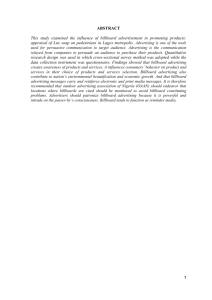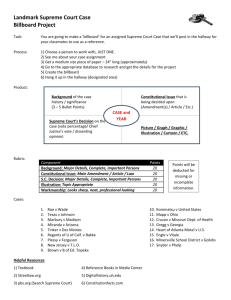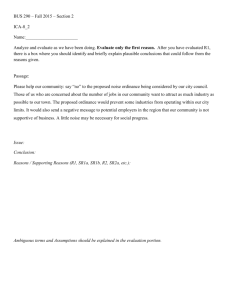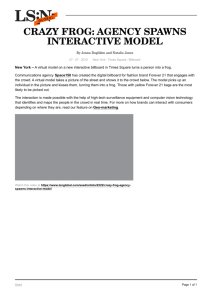CAP & TRADE - Land Use Law
advertisement
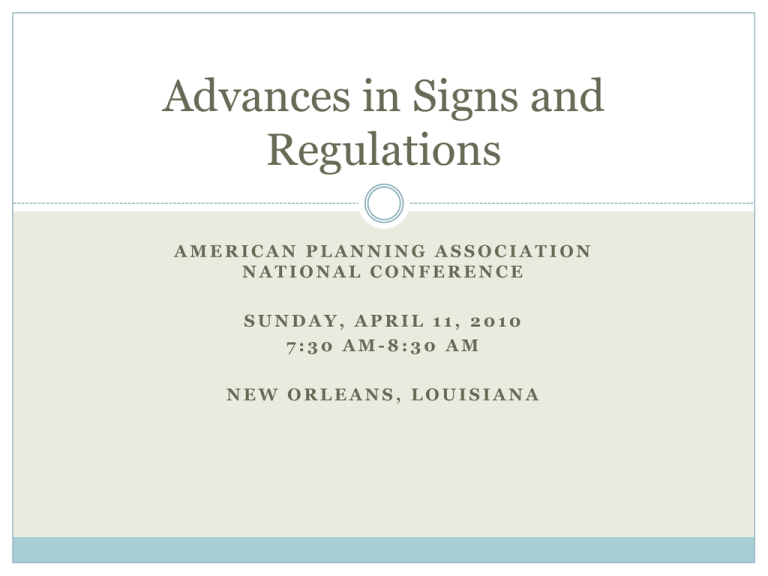
Advances in Signs and Regulations AMERICAN PLANNING ASSOCIATION NATIONAL CONFERENCE SUNDAY, APRIL 11, 2010 7:30 AM-8:30 AM NEW ORLEANS, LOUISIANA Panelists John M. Baker Attorney and Founding Partner, Greene Espel PLLP, Minneapolis, MN Adjunct Professor, William Mitchell College of Law, St. Paul, MN Daniel R. Mandelker Howard A. Stamper Professor of Law, Washington University, St. Louis, MO Overview Dynamic Displays Local regulations: a continuum from prohibition to encouragement Court Decisions and Constitutional Principles that Affect Regulation of Dynamic Displays First Amendment law Nonconforming use law Mobile billboards What legal principles apply Billboards that shock or seduce When adult entertainment and billboards converge Dynamic Displays One style: an standard “billboard” (usually called an “off-premise” sign, because it does not advertise something offered on the sign’s premises) that has been converted to a digital display How: replacement of the face with a thicker face made up of an array of thousands of LEDs Dynamic Displays They are capable of o* Television-like presentations; o* Synchronized use (across several dynamic displays); o* Sequencing – taking a single sentence or phrase and stretching it out across several displays, inducing watchers to stare at it to see how the message ends Dynamic Displays Another type: part of an “on-premise” sign Offers the opportunity to provide not only way-finding information (the businesses’ name and logo) but also specific products and services The Attraction: Change Selling “time” rather than “space” Allowing multiple advertisers to use a single sign Using “change” itself to better catch the attention of drivers, passengers and pedestrians because the change itself is The ability to remotely update the content The Danger: distraction The latest: Des Moines funeral home uses digital displays to announce time and place of funerals One commentator “Wouldn't you like drive into a telephone pole if you saw your neighbor up there and didn't know? “ "What are you going to do, pull off and mourn?" Dynamic Displays MODES OF REGULATION A. Complete or near-complete bans A broad prohibition, Supported by broad definitions; and No exceptions, or ones that are crafted with safety in mind Example: Denver’s March 2010 ban “Outdoor general advertising devices may not have message surfaces made entirely or partly of light emitting diodes (LEDs).” Even for LED billboards in place when the ban was adopted, “LEDs on such device may not flash, blink or fluctuate, or change in any manner more frequently than once per hour, must be dimmed at dusk and may not be lit between the hours of 1:00 a.m. and 6 a.m.” Section 59-570, amended March 8, 2010. B. If your city generally dislikes such signs but not these kinds One suburb’s general approach Citywide permission to operate dynamic displays, under . . . Strict conditions designed to reduce – Proliferation, and Distraction Examples of restrictions Long minimum display time: 20 minutes Only a percentage of a sign can be dynamic Dynamic text cannot be too small How? Set a minimum font size that varies by the speed limit on the road Sources of standards: the sign industry’s “best practices” formula C. Allowing them if more static signs come down The underlying principle: one sign that is dynamic allows consolidation of many Minnetonka, Minnesota’s “incentives” provision The City had a restrictive ordinance and enforcement stance Long minimum display period Only a small percentage of the sign can be dynamic The owner of nearly all billboards in the City offered: We’ll take down half the billboards in town (an keep at least ½ of the rest static) if up to 8 others can become fully dynamic and change every eight seconds Minnetonka’s incentives approach The City proposed which static signs should come down (based on safety and planning criteria included in the ordinance) A side agreement keeps more than one dynamic billboard from being visible at any single place The 8-second duration was hard for the City to swallow, but Minnesota law allowed no better way for the City to get rid of so many billboards D. Allowing flashy signs in selected districts Minneapolis: flashing signs are lawful only in its “downtown opportunity billboard district” East Dundee, IL: car dealerships, retail centers and amusement establishments can use – Video signs (in one overlay district) PowerPoint-type displays (in another one) Cases on Digital Signs Prohibiting Digital Signs Naser Jewelers, Inc. v. City of Concord, 513 F.3d 21 (1st Cir. 2008) (New Hampshire) Content Neutrality A threshold question is whether the restriction is content-neutral A regulation that serves purposes unrelated to the content of expression is content-neutral Goals and Purposes The statement of purpose includes promoting traffic safety and community aesthetics We look to the legislative body’s statement of intent Narrow Tailoring Concord’s interests in traffic safety and community aesthetics would be achieved less effectively without the prohibition Need for Studies? Naser Jewelers argues that Concord must perform studies to uphold the ban Court: concord was under no obligation to do such studies or put them into evidence Alternative Channels Exist Naser Jewelers can use static and manually changeable signs, place advertisements in newspapers and magazines and on television and the Internet, distribute flyers, circulate direct mailings, and engage in cross-promotions with other retailers. Dynamic Signs and Nonconforming Use Law If billboards are prohibited, but remain as a prior lawful nonconforming use, do the privileges of that status include the right to convert a static display to a digital display? Conversion Prohibited Adams Outdoor Advertising, L.P. v. Board of Zoning Appeals, 645 S.E.2d 271 (Va. 2007) Ordinance: “No nonconforming sign shall be structurally altered, enlarged, moved or replaced” Court Holding “The electronic message board added between 3,000 and 3,500 pounds to the weigh of the billboard . . . [It] did not increase the billboard’s height, length, or the square footage of its advertising surface area [but increased the billboard’s depth.” The billboard company did not have the right to convert the static sign to a digital display Another example Clear Channel Outdoor, Inc. v. City of Arden Hills, (Minn. Dist. Ct. Aug. 1, 2008) Trial Court Adams Outdoor decision’s three-dimensional logic Because the conversion increased sign depth, it’s a forbidden expansion of the nonconforming use Clear Channel appealed, but the appellate court avoided the issue, affirming on other grounds The Result: A Dark Dynamic Display Motor Vehicle Signs CASE LAW AND REGULATION Starting point, or anachronism? Railway Express Agency, Inc. v. New York, 336 U.S. 106 (1949) Upholding city ordinance providing that “No person shall operate, or cause to be operated, in or upon any street an advertising vehicle.” This decision pre-dated First Amendment protection for commercial speech More recent decisions Showing Animals Respect & Kindness v. City of West Hollywood, 83 Cal. Rptr.3d 134 (Cal. App. 2008) The West Hollywood Ordinance upheld Part A: It is unlawful for any person to conduct, or cause to be conducted, any mobile billboard advertising upon any street, or other public place within the city in which the public has the right of travel. §11.44.020 The West Hollywood Ordinance upheld Part B: “Mobile billboard advertising” includes any vehicle, or wheeled conveyance which carries, conveys, pulls, or transports any sign or billboard for the primary purpose of advertising. §11.44.020 Definition and Prohibition Of Mobile Billboards Supersign of Boca Raton, Inc. v. Ft. Lauderdale, 766 F.2d 1528 (11th Cir. 1985) Ft. Lauderdale Ordinance Upheld General prohibition: It is unlawful for any person to operate, or cause to be operated, any advertising vehicle or watercraft in or upon any roadway, waterway, marine area, or other public place within the city in which the public has the right of travel. An “advertising vehicle or watercraft” is any wheeled conveyance or any waterborne craft designed or used for the primary purpose of displaying advertisements. Fort Lauderdale Ordinance Upheld Exceptions: Any vehicle or watercraft which displays an advertisement or business notice of its owner, so long as such vehicle or craft is engaged in the usual business or regular work of the owner, and not used merely, mainly or primarily to display advertisements; (b) Buses; or (c) Taxicabs. Model Proposed Ordinance Mobile billboard. Any sign displayed upon a vehicle where the principal purpose of the vehicle is not general transportation, but the display of the sign itself. It shall be unlawful for any person to display any mobile billboard Signs that shock WHEN ADULT ENTERTAINMENT COMES OUTSIDE OF THE CLUB Signage on Adult Businesses General First Amendment Principles There is no question that minimizing the secondary effects of sexually-oriented businesses serves a significant governmental interest. See City of Renton v. Playtime Theatres, Inc. 475 U.S. 41 (1986) More recent decisions: Pleasureland Museum Pleasureland Museum, Inc. v. Beutter, 288 F.3d 988 (7th Cir. 2002) “Mishawaka justifies the Signage and Painting Restrictions as narrowly tailored to combat urban blight and to prevent a decline in the value of surrounding properties. Mishawaka asserts that the restrictions are necessary to minimize the visual impact of the businesses on the neighborhood by making the businesses blend into their surroundings.” Pleasureland Museum (cont’d) [W]e invalidate the Signage Restriction in Section 125.16(D)(1), which limits signage to "only the legal name of the enterprise," because it is substantially broader than necessary to achieve Mishawaka's goals. Mishawaka fails to articulate a single reason why it is necessary to limit a sexually-oriented business' signage solely to displaying its name. Excalibur Group v. Minneapolis 116 F.3d 1216 (8th Cir. 1997) The Minneapolis Ordinance: (1) All signs shall be flat wall signs. (2) The amount of allowable sign area shall be one square foot of sign area per foot of lot frontage on a street. The Minneapolis Ordinance (cont’d) (3) No merchandise or pictures of the products or entertainment on the premises shall be displayed in window areas or any area where they can be viewed from the sidewalk in front of the building. (4) Window areas shall not be covered or made opaque in any way. No signs shall be placed in any window. A one-square-foot sign may be placed on the door to state hours of operation and admittance to adults only. Why the Minneapolis law is constitutional “We hold that the restrictions in subsection (g)(4) are narrowly tailored to further the city's significant interest in alleviating the adverse impact of sexually oriented businesses on their neighborhoods. Having before it substantial evidence of the urban blight caused by the mere presence of these businesses, the city could reasonably conclude that controlling their outward appearance would lessen the effect they would have on surrounding commercial and residential neighborhoods.” Why the Minneapolis law is constitutional (cont’d) “The restriction in subsection (g)(3) prohibiting the visibility of sexually oriented speech through the windows of these establishments falls within the legitimate sweep of the ordinance. Thus, there is nothing overbroad about subsection (g)(3)'s regulation of displays of sexually oriented speech.” MD II Entertainment v. City of Dallas 28 F.3d 492 (5th Cir.1994) The Dallas law: Dance hall defined as any place: [T]hat is advertised either on or off the premises: (i) as topless; (ii) as a gentleman's club, bar, or saloon; (iii) as adult entertainment; (iv) as x-rated; or (v) by any other term calculated to attract patrons with nudity, semi-nudity, or simulated nudity Why Dallas Lost "The city has made no finding ...that advertising that employs the term "gentleman's club' produces the deleterious effects which the city seeks to curb" “The City has put no evidence in the record that forbidding the use of any "term calculated to attract patrons with nudity, semi-nudity, or simulated nudity" in commercial advertising is narrowly tailored to prevent the erosion of property values or reduce crime rates.” Dan’s Website Law.wustl.edu/landuselaw Presentations are available Questions?
